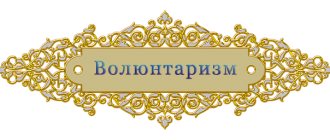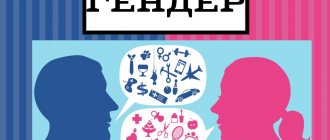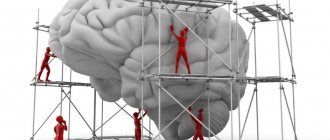Morality - what is it in simple words?
Brief Definition
The word “morality” has been known to many since childhood. Even before a child hears this term itself, he is already learning to observe moral standards. He is taught how to behave in order to fit into society, not to harm himself and others.
In short, morality is the rules accepted by members of society that must be followed. In simple words, morality is the rules that reflect the moral level of society. Also derived from these rules are norms of behavior in accordance with which members of society should behave.
A broader definition of this concept dates back to ancient times. Morality among the ancient Romans is the most general ideas about what is good and evil, right and wrong, honest and dishonest.
On the other side
The legend about the turnip is no less interesting and symbolic. In old times, this plant was associated with the moon, and the tale itself told about the movement of the celestial body and its transformations during the lunar month. All the heroes help pull the turnip out of the ground, and it moves slowly and very little by little - just like a celestial body. We can safely say that the story about the turnip, as well as the legend telling about Kolobok’s journey, are astrological tales with meaning. They were invented in ancient times to make it easier to explain to a child why and how the Moon moves across the sky. The explanation for a modern person is not the most obvious and understandable, but in many ways this can be associated with a change in the logical chains that people form when reasoning - apparently, in ancient times they were somewhat different.
No less interesting is the tale about the hare's hut - it is also considered astrological. The roots of the story of the Golden Scallop are similar. The rooster was a symbol of the sun. In the story, the fox comes to the window to call the sun. Researchers of folk art say that the various creations of that period are generally characterized by an abundance of calls to the sun - people’s lives largely depended on it. The fox grabs the rooster and takes it to distant lands. If we analyze the text from the point of view of a modern educated person, it seems that the path that the heroes take is too far, completely unjustified. It reflects the journey of the luminary across the sky. The fox symbolizes the night, stealing the source of light, and the cat reflects the morning, with which the warmth returns.
But the legend about the hare's hut, according to scientists who have studied folk art, was created to convey to children how the seasons change. The fox symbolizes winter, while the hare is a summer image. The rooster-sun helps the hare to triumph over the winter-fox, because the sun is stronger than the cold.
What distinguishes morality from laws?
Inquiring minds often ask the following question. Many aspects of people's lives are regulated through legislation. The basic laws are similar everywhere, regardless of the specifics of the state: for example, they prohibit killing, except in specified cases, for example, killing an enemy on the battlefield. The law prohibits theft, fraud, the use of deception and violence in order to take possession of someone else's property.
That is, a huge part of the norms of behavior in our lives are determined by laws. How does morality differ from them, why is it needed at all? The following answers can be given to this question.
Distinctive features of moral standards
- Universal obligation. Some categories of people cannot be convicted by law, for example, due to their young age or other reasons. Moral norms imply that for a bad deed, everyone who committed it will receive condemnation.
- Voluntariness. Perhaps this is the main distinguishing feature. All residents and guests of the state are required to comply with the law. Compliance with moral standards lies on the conscience of each individual person. It depends on his upbringing and personal qualities, as well as his personal opinion about reasonableness and the acceptable framework of morality.
- The special nature of sanctions for non-compliance. This sign follows from the previous one. If failure to comply with state laws is punishable by criminal or administrative penalties, failure to comply with moral standards is punishable by public censure.
- Inclusiveness. Moral laws apply to everyone - from major politicians to ordinary citizens.
In the dictionary Dictionary of foreign words
and, f.
1. pl. No. Rules of morality, as well as morality itself. A man of high morals.||Cf. ETHICS" title='ETHICS, ETHICS is, what is ETHICS, ETHICS interpretation'>ETHICS.
2. A logical, instructive conclusion from something M. fable.||Cf. APOPHEGMA" title='APOPHEGMA, APOPHEGMA is, what is APOPHEGMA, APOPHEGMA interpretation'>APOPHEGMA (APOPHTEGMA" title='APOPHTEGMA, APOPHEGMA is, what is APOPHEGMA, APOPHEGMA interpretation'>APOPHTEGMA).
3. decomposition Moral teaching, instruction. Read m.||Wed. NOTATION, RACE.
Share the meaning of the word:
Moral standards
The norm, in simple words, is everything that is correct, good and natural. Applicable to the moral sphere of life, this is how one should act and what should be kept in mind as a life guide.
Humanity inevitably changed along the way of its development. Moral guidelines also changed. But in fact, these changes have not been so significant since the times of ancient states. The basic moral norms that operate in modern society arose simultaneously with ancient civilizations. Here they are:
- Politeness . You should never be rude, even when communicating with someone who is lower in status than you. In the modern world, where there are no classes, this applies to all people. Politeness should be observed regardless of whether the interlocutor is older or younger, richer or poorer. Rudeness and rudeness are considered signs of bad manners.
- Prudence . Rash actions are not approved by society. In addition, prudence carries another meaning. One should act in the name of the global good, and not momentary desires.
- Hard work . You should perform your work, household, and family responsibilities efficiently, with dedication and diligence. Not only can laziness lead to conflicts and dismissal, but it is also not encouraged by society as a whole. It is believed that a lazy person is useless to society.
- Justice . Each situation must be judged taking all factors into account. You should not be guided by personal interests.
- Persistence . There are various difficulties in life, but you need to be able to overcome them and not lose heart.
- Temperance . Excessive enjoyment of goods leads to poor results in fulfilling duties.
Functions of morality
Now it’s worth answering the question: why are moral standards needed at all? They have five main functions.
- Estimated. It allows you to distinguish evil from good, good from bad, cruel deeds from good. Guided by morality, one can understand whether a person is doing good or bad.
- Regulatory. It implies the creation of new norms and principles in accordance with changes in society.
- Educational. It allows children to form a moral picture of the world and develop their ideas about the norms of behavior in society.
- Control function. Designed to ensure compliance with the rules, and, if necessary, impose sanctions on their violators.
- Integration function. Helps society to be more united by maintaining the same standards and reasonable, kind behavior.
And geese and swans
No less curious is the meaning of the fairy tale “Geese-Swans”. The legend tells about a girl who did not look after her brother, who was stolen by birds. The beginning of events is the need to return under the wing of the parents. The fairy tale was invented to explain to children the importance of obedience and compliance with the prohibitions established by elders. Researchers of earlier times know that the Slavs believed in the existence of a physical and spiritual world. In ancient times, they revered their ancestors, believed in the sacred world order and the need to overcome trials before entering adult independent life. It is them that the plot of this legend shows, which is why in it the child is carried away by geese-swans - white birds, symbolizing a new start in life and insight. These birds seem to be on the border between life and death - this is how it was seen in ancient times. The swan, as can be learned from sources that have survived to this day, was perceived by the Slavs as a symbol of flowing water.
Education of morality
From early childhood we begin to be told about what is good and what is bad. Parents and other older relatives, educators and teachers instill moral standards in children. The rest of society also participates in this - by communicating with other children in the team, the child also absorbs certain norms.
How does education and instilling of moral guidelines take place?
- Personal example . The most effective, although underestimated by some, method. By nature, a child is an imitator. This is absolutely normal. In animals, young animals learn exclusively through imitation of adults, and this is also typical for humans. If parents follow moral principles, then the child, looking at them, will try to do the same.
- Morals . By talking with a child about the rules of behavior, you can convey to him much of what he does not understand.
- Art . Books, films and animation, plays and music convey moral standards to children under the guise of exciting stories.
- Personal experience . If a child strives to do the right thing over and over again, and sees that this leads to positive results, he will strive to do so in the future.
Yesterday Today Tomorrow
As experts say, in order to understand and perceive the meaning of Russian folk tales, you need to be able to abstract from the world we are familiar with. It’s easier to understand what the tales are about if you can look at the structure of the planet from the point of view of a person who lived in former times - after all, it was then that fairy tales appeared that captured the features of everyday life. They were created to make it easier to explain to children how to interpret what is happening around them. Some believe that in recent centuries folk art has been deliberately distorted, making it very difficult to correctly perceive famous works.
Even one fairy tale was sometimes enough to convey to the child how the world around him works. The tales were intended to make things easier to explain and teach. If we draw parallels with the modern concept, we can say that fairy tales are such archived data packets, the passwords for which are known only to a select few. The importance of legends cannot be underestimated, since these epics pass on images from generation to generation. According to many linguists, the Russian language is very, very figurative, not just a set of letters and their combinations. Originally, the language was formed as a system of images, the interpretation of which depended on the context. This is very clearly visible in fairy tales: there are a lot of options for assessing the meaning of one legend.
What types of education, on the contrary, do not work?
- Moral teachings contrary to personal example. If parents persistently tell their child how bad it is to lie, swear and drink alcohol, and they themselves regularly lie, argue and get drunk, such upbringing will not give a positive result. All methods of education must be integrated and not contradict each other.
- Imposing norms through constant punishments and scandals. The child will strive not so much to observe moral principles because they are correct and good, but rather to strive to avoid punishment. To do this, he will lie and hide his bad deeds.
- Art without analysis. Just showing your child a cartoon about good and evil or reading a book is not enough - he can understand the work in his own way. It is worth talking to him about the meaning of what he saw or heard, to make sure that he understood everything correctly.
From different sides
The meaning of the title of the fairy tale is also curious, as it immediately makes it clear who exactly is the central object of the tale. As interpreters say, the chicken symbolizes higher powers, the creator and creator, the supreme deity. She gives everyone as much as they need. A person may not be able to cope with what is given to him, and he has to live as usual, like everyone else, and others even feel empty. To prevent this from happening, you need to value and take care of the golden egg.
How to relax mentally?
First of all, it is worth keeping in mind that mental stress is inseparable from physical stress. You have probably noticed that after conflict and difficult mental situations, muscles tense and different parts of the body hurt. The body is the seat of the soul, so moral relaxation includes physical relaxation.
The main way to relax and get rid of tensions at all levels is meditation. It allows you to stop wasting energy on trifles - constantly thinking about situations that cannot be solved immediately, as well as maintaining unnecessary tension.
Proper meditation technique for relaxation at all levels
There are a few things to consider before you start practicing meditation. This practice requires some work, and it is not so easy to master. But those who own it are able to fully relax in 20-40 minutes more than those who don’t – in an entire night of sleep.
For meditation you will need silence and solitude.
- Body position – lying on your back or sitting upright on a chair. In any case, your back should be straight. You need to stretch the top of your head straight, feeling how your spine stretches. The eyes should be closed - the main perception is now tactile. You need to feel the part of the body that relaxes.
- Each part of the body must be felt in turn. Bring all your attention to your right leg. Feel how the muscles relax in it - from the hip to the foot. Repeat the same with your left leg.
- Feel how your hands relax one by one.
- Relax the muscles of your back, abs, chest and shoulders. Feel the tension release from them. Feel that your torso is no longer constrained by the need to constantly hold in an unnatural position.
- Relax your neck and facial muscles.
This meditation requires some practice. One day you will feel like you did everything right. Then your body will be in a state close to weightlessness - as free and relaxed as possible. You will feel that a little more - and soar from the resulting lightness.











